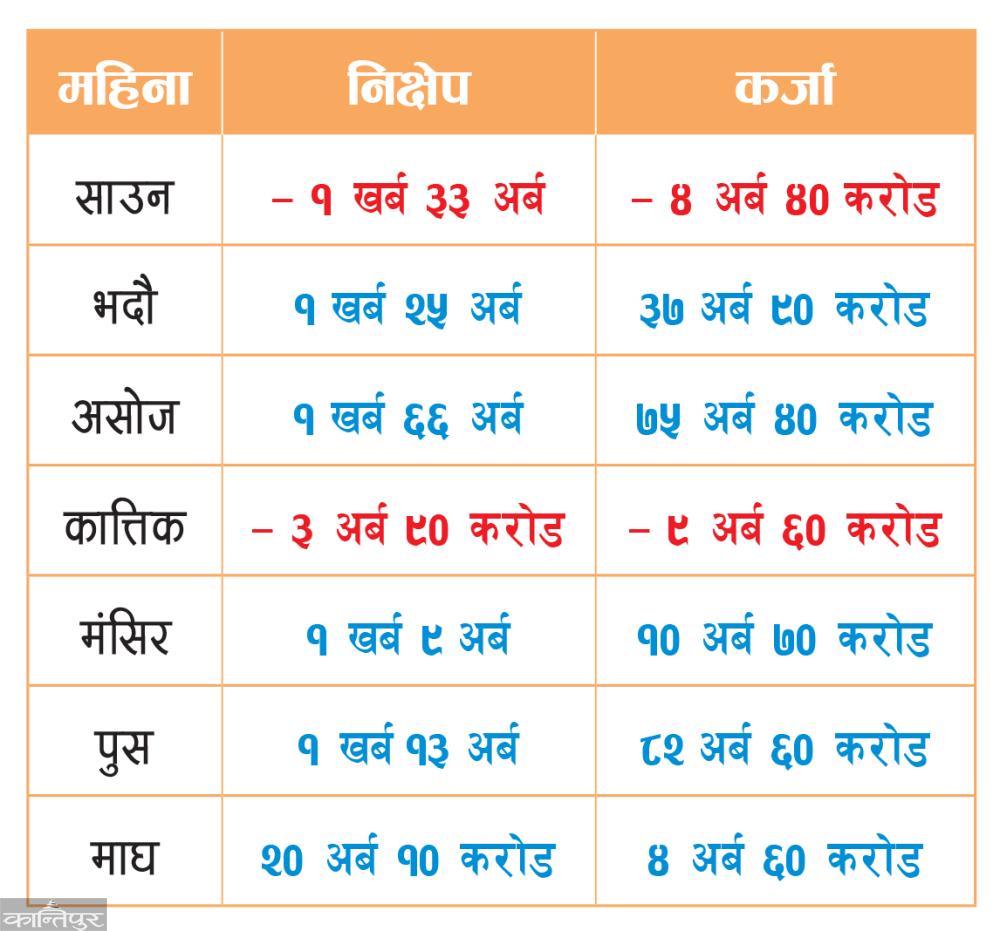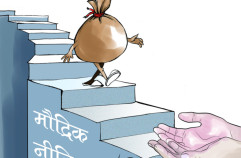6 trillion 61 billion accumulated in the bank
We use Google Cloud Translation Services. Google requires we provide the following disclaimer relating to use of this service:
This service may contain translations powered by Google. Google disclaims all warranties related to the translations, expressed or implied, including any warranties of accuracy, reliability, and any implied warranties of merchantability, fitness for a particular purpose, and noninfringement.

6 trillion 61 billion investable amount has been accumulated in the bank since the loan disbursement has not increased. Although the credit demand is expected to increase from the beginning of the current year due to improvement in the external indicators of the economy, decreasing interest rates, sufficient liquidity etc., the credit disbursement has not increased as expected due to the economic situation not being as expected.



Banking expert Parshuram Kunwar Chhetri said that the private sector is not excited for more investment as the private sector is not excited for more investment as the market demand has decreased and there is a decrease in business. As of last Monday (April 12), the total deposits of banks and financial institutions are 61 trillion 94 billion and loans are 50 trillion 82 billion. Adding bonds and loans brought by banks from abroad to the total deposits, the total resources come to 62 trillion 81 billion," he said. "Banks and financial institutions can give loans up to 90 percent of the mentioned total resources. Now this ratio is 79.64 percent. Based on this, banks and financial institutions currently have around 6 trillion 61 billion investable capital accumulated.'
The main reason for the inability to increase credit flow is financial laxity He said that there is. "There is no problem with bank interest rate, price increase, etc.," he added.
In the eight and a half months of the current year (up to April 12), a total of 4 trillion 23 billion rupees of deposits have been collected in banks and financial institutions. This is an increase of 7.33 percent. In the same period, loans of 2 trillion 4 billion rupees have been disbursed. Loan growth is 4.14 percent.
Rastra Bank had set a target of 11.5% loan disbursement in the current year. Looking at the data of the past eight and a half months, the experts say that the increase in lending this year will hardly be around 5 to 6 percent.
Bhuvan Dahal, the former president of Nepal Bankers Association, said that since the loan demand did not increase as expected, a large amount of money was accumulated in the bank and it appeared that the loan could not be expanded as per the target. "It seems that only half of the annual target will be extended," he said. Looking at the loan-deposit ratio, more than 6 trillion investable funds are seen with the banks. However, looking at the basis of net liquid assets, there is about 4.5 billion investable capital.'
At present, banks and financial institutions must maintain a minimum of 20 percent of net liquid assets of deposits. As of last month, the average net liquid assets of banks and financial institutions is 27 percent. Although there is sufficient liquidity in the overall financial system, some banks' primary capital funds and total capital funds are under pressure. Therefore, they have not been able to disburse loans as expected. However, Dahal says that there is sufficient capital for lending in the overall financial system.
'Due to the problems seen in the economy, loan demand has not increased. For this, both the Ministry of Finance and the National Bank should encourage them to expand investment through effective dialogue with the private sector, he said, "In such a situation, the government should entrust the construction of large infrastructure projects, including roads, to the private sector instead of increasing expenditure by taking loans." In order to encourage the private sector in this process, the government can provide facilities such as interest discounts. In terms of
credit-deposit ratio (CD ratio), banks have the capacity to provide loans of more than 6 trillion rupees, said Prakash Kumar Shrestha, Head of Research Department of Nepal Rastra Bank. "Until Tuesday, there is about 1 trillion 50 billion rupees excess liquidity in the financial system (excluding the mandatory cash balance)," he said. When all sources are added, this amount is more than 6 trillion.
Due to the effects of relaxation in the economy, money has accumulated in the bank due to the lack of loan demand, and this year the loan cannot increase as per the target, he said. "Loan demand has not increased, if this is the case, it seems that the loan will increase only by 5/6 percent," he says, "There is a situation of excess liquidity in the financial system." This is the reason why the National Bank has now withdrawn 1 trillion 48 billion rupees from the market for liquidity management. told.
According to experts, consumption has decreased due to the decrease in the real income of the consumers and this has also decreased the overall demand. Citizens have not been able to spend. Government spending is minimal. On the one hand, the price increase has not decreased to the extent that the citizens feel it, on the other hand, there is no basis for creating new demand," said a chief executive officer of a commercial bank, "The turnover of industrial businesses has decreased to 30/40 percent. Overall production and productivity is low. The interest rate has not decreased as the turnover has decreased.'
The official said that there is a problem due to the lack of effective coordination between the country's financial policy and monetary policy. He says that the problem is that both policies are not moving in the same direction. Similarly, in two months (July and October) out of 7 months of the current financial month, credit expansion and deposit collection are both negative, while the rest are positive.

Similarly, among the loans that are being invested by banks and financial institutions, agricultural loans are 0.8, industrial production loans are 8.8, construction loans are 4.9, transportation, communication and public service loans are 7.4, and wholesale and retail trade loans are 3. 0, service industry credit increased by 5.6 percent and consumer sector credit increased by 6.9 percent.
'Until last January, among the loans disbursed from banks and financial institutions, periodic loans were 14, cash flow loans 26, trust receipt (import) loans 11.1, real estate loans (including personal residential house loans) 5.2 and margin loans 11.6 has increased by 100%," the monthly report of the National Bank states, "overdrafts have decreased by 42.3 percent and higher purchase loans by 20.3 percent."
Although the external sector looks good, the domestic economy remains sluggish. Foreign exchange reserves are at an all-time high, current account and current account are in surplus, inflation is also under control. Experts say that all these are guided by the policies of other countries rather than our reasons. They say that because the results of our policies and initiatives are very disappointing, the slackness of the economy has not been removed. They claim that the economy has slowed down due to restrictions on the speed of credit disbursement, a large number of young people migrating, and the inability to increase public spending, resulting in reduced market demand. There is very little capital expenditure of the allocated budget, construction business, dairy farmers, agricultural insurance, corona insurance, interest subsidized loans, export subsidies, etc. are yet to be paid by the government. This suggests that the private sector is fueling the economic slowdown.
In such a situation, economists say that the government should not waste money to improve the economy. They say that there is a challenge of revenue, and to keep public expenditure running, the government should immediately pay the good projects that have been stopped and its other obligations.
'Government's responsibility
must be paid immediately'
Nar Bahadur Thapa, Former Executive Director Nepal Rashtra Bank
Why didn't the loan flow increase even when the interest rate is falling and there is sufficient liquidity?
There are two main reasons for this situation. First, economic activity has not been sustained due to a sluggish economy and non-payment of liabilities by the government. This is the reason why there has been a slowdown in business. In this situation, the private sector could not invest more. Secondly, this situation has come about when the capital fund is under pressure due to the increase in bad loans in banks.
How did the situation of having to accumulate money in the bank for a long time?
A major reason is the government's financial policies at all three levels. On the one hand, the government has not been able to spend capital as expected, and on the other hand, it has yet to pay the amount due to construction businessmen, dairy farmers, agricultural insurance, corona insurance, interest subsidized loans, export subsidies, etc. State and local governments are also unable to spend, so money has been piled up in the National Bank. In this way, the builders have not been able to pay the interest due to the lack of money in the market. It is the bank's bad loan
is increased. Employment opportunities have not been created due to lack of government spending. This has reduced the consumption of citizens.
To what extent do you see Rashtra Bank responsible for this situation?
Due to the weakness of Rashtra Bank, loans were expanded aggressively in the past. Rastra Bank also provided re-loan facility by printing money. However, now the National Bank has made a 'course correction'. According to which the mistakes of the past are being corrected and moving forward. Therefore, the financial policy should be more active than the monetary policy to make the economy run.
Could the private sector have expanded loans significantly with reduced interest rates?
Now the confidence of the private sector is very low. The private sector's contribution to national capital formation and investment is 80 percent. Only 20 percent of the government. However, to encourage the private sector to invest, the government should initially increase investment itself. So that the private sector, which contributes 80 percent, will be encouraged to invest with confidence.
What should the National Bank do to solve the current problem?
At present, the National Bank does not need to improve the monetary policy much. However, in order to control the pace of credit expansion, the National Bank has made arrangements for banks and financial institutions to maintain a 0.5 percent 'counter-cyclical buffer' until next June. As this arrangement puts pressure on the capital fund, the credit disbursement capacity of the banks decreases. The National Bank may postpone the provision for some time to increase the speed of loan expansion.
What should the private sector do to improve the economy?
s The private sector has not always just lashed out at monetary policy. The problem lies in fiscal policy. The economy will move in a balanced manner through effective coordination of fiscal policy and monetary policy. At present, the direction of the monetary policy has not been able to catch up with the financial policy. Weaknesses should be corrected and brought into rhythm.
प्रकाशित : चैत्र १५, २०८० ०६:१६

 १९.१२°C काठमाडौं
१९.१२°C काठमाडौं














